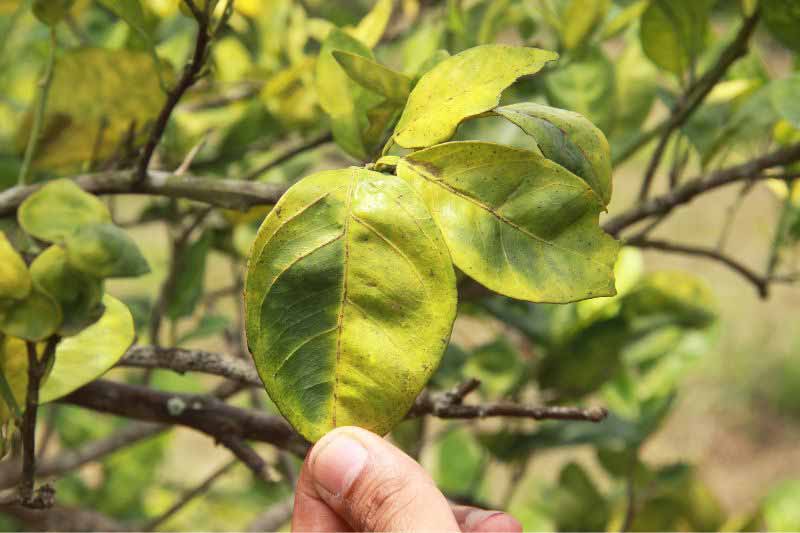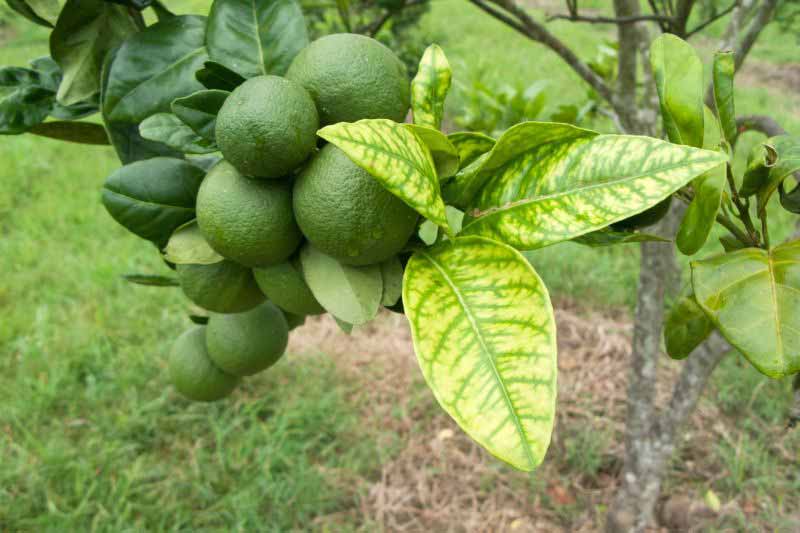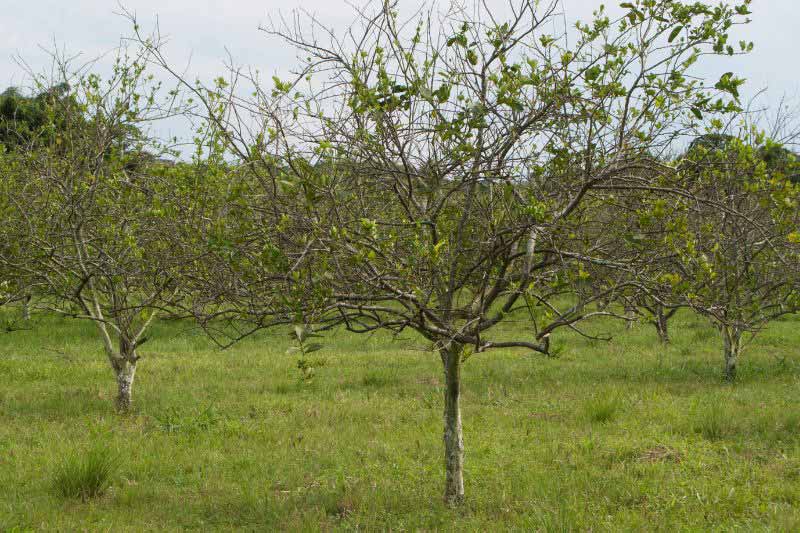The Yellow Dragon disease, scientifically known as Huanglongbing (HLB), is one of the most serious current threats to citrus production worldwide. Caused by a deadly bacterium, this disease affects oranges, lemons, mandarins, and grapefruits, leading to significant economic losses and jeopardising the future of citrus orchards. Let’s explore the origins, symptoms, modes of transmission, consequences, and solutions to combat this scourge.
What is Yellow Dragon disease (HLB)?
Yellow Dragon disease (HLB), or Huanglongbing, was first identified in the early 20th century. It was described in China in 1919, where it was known as the "yellowing disease" of citrus. At that time, farmers observed symptoms of irregular leaf yellowing and tree decline, but the precise causes of the disease were not yet known. It was not until the 1940s-1950s that further research allowed for a better understanding of its bacterial origin and its transmission by vector insects. Since its emergence, the disease has spread rapidly, affecting Asia, Africa, Latin America, the United States, and even some regions of Europe. Today, it is considered one of the greatest threats to global citrus production. Associated losses are estimated to be in the billions of dollars each year.

What is the pathogen of the dragon?
The Yellow Dragon disease is caused by a bacterium belonging to the genus Candidatus Liberibacter. Three main variants of this bacterium are known: asiaticus, africanus, and americanus. All attack the vascular system of citrus, blocking the circulation of nutrients and leading to tree decline.
Symptoms of Yellow Dragon disease
The first signs of the disease appear on the leaves, which exhibit irregular yellowing often confused with nutrient deficiencies. Unlike other diseases, the yellowing of leaves caused by HLB is asymmetrical, affecting part of the lamina while the other remains green. The fruits of infected trees become small, misshapen, and their taste is altered, often bitter or bland. The skin of the fruits may also show unusual colour spots.
As the disease progresses, the entire tree shows signs of decline. Leaves and fruits drop prematurely, growth slows, and if no intervention is made, the tree eventually dies. Once infected, a tree cannot be cured, making early detection and prevention essential.
In summary:
- Irregular yellowing of leaves
- Small, misshapen, and often bitter fruits.
- Irregular skin coloration.
- Premature dropping of leaves and fruits.
- Slowed growth.
- Possible death of the tree.

How does the disease spread?
The bacterium is transmitted by vector insects, primarily the Asian citrus psyllid (Diaphorina citri) and the African citrus psyllid (Trioza erytreae). These small insects feed on the sap and spread the bacterium from an infected tree to a healthy one. The dissemination of the disease is exacerbated by the transport of infected plants or contaminated grafts, usually from one region to another. The globalisation of agricultural trade has significantly contributed to the spread of the disease, making control even more complex. Poor agricultural practices and a lack of awareness in certain regions further worsen the situation.

What cures the dragon disease?
Currently, there is no definitive cure for Yellow Dragon disease (HLB). HLB is an incurable disease. Once a tree is infected by the bacterium Candidatus Liberibacter, it cannot be cured. This is why prevention is key to protecting orchards.
Economic and environmental consequences
The impacts of HLB are catastrophic for producers. Yields drop dramatically, as fruits from infected trees cannot be marketed. Costs increase in attempts to control psyllid populations or replace lost trees. Yellow Dragon disease (HLB) has profound repercussions on the global economy, particularly in regions where citrus cultivation is an agricultural and commercial pillar, threatening the citrus sector.
Countries heavily dependent on citrus, such as Brazil, the United States, Mexico, and India, incur colossal losses each year. The decline in yields, combined with rising management costs (pesticides, replacement of infected trees, orchard monitoring), puts farms under pressure.
For many small farmers, these losses can be insurmountable, leading to bankruptcies and migrations to less affected crops. Beyond orchards, the repercussions are felt in the agri-food industry: the entire citrus supply chain is impacted, from processing (juices, jams, essential oils) to export. Fruit shortages drive up prices in the market, making products less accessible to consumers.
Increased use of pesticides
The fight against HLB also has concerning ecological impacts, particularly in areas where intensive practices dominate. To control psyllid vector populations, producers often turn to intensive chemical treatments. While these pesticides may temporarily reduce infestations, they pose major environmental problems.
Loss of biodiversity in orchards and indirect deforestation
Intensive monocultures of citrus, particularly vulnerable to HLB, are already ecologically fragile. The massive removal of infected trees, combined with intensive chemical management, exacerbates the loss of biodiversity in orchards, making them even more vulnerable to other diseases and pests. To compensate for losses caused by HLB, some producers clear new land to plant citrus, contributing to the destruction of natural habitats.

Control strategies and prevention
In the face of this threat, combating HLB relies on several axes. Prevention plays a key role. Strict phytosanitary controls aim to limit the spread of the disease through international trade of plants. Training farmers to detect early symptoms is also essential for rapid intervention.
Managing vector insects is another lever. Producers resort to insecticides to reduce psyllid populations, although this approach requires precautions to minimise its ecological impact. Alternative methods such as using traps or introducing natural predators, such as ladybirds, offer more sustainable options.
When trees are infected, their rapid removal is imperative to prevent contamination of neighbouring trees. Researchers are also actively working on selecting citrus varieties resistant to the bacterium, although this process is still ongoing.
What are the prospects?
Combating HLB, or Yellow Dragon disease, requires a comprehensive and multidimensional approach to protect global citrus production. The prospects rely on promising scientific advances, such as the creation of resistant citrus varieties through genomic editing (CRISPR), the use of bacteriophages, natural viruses, to target the bacterium Candidatus Liberibacter, and the search for vaccines to immunise trees. Initial tests of vaccines or resistant varieties show encouraging results.
To control psyllid vectors, sustainable alternatives to pesticide use are preferred, as seen, such as biological control using natural predators (ladybirds, parasitoid wasps), disrupting insect reproductive cycles with pheromones, and integrating companion crops to repel or attract these pests.
Modern technologies, including drones and artificial intelligence, also enable effective monitoring of orchards and early detection of infected trees, facilitating rapid interventions. Finally, regenerative agriculture, which enriches soils and strengthens the natural resilience of trees through practices such as adding compost or using cover crops, is a key solution to reduce the vulnerability of citrus to diseases. These combined efforts aim to limit the economic and environmental impacts of this disease while ensuring the sustainability of citrus production and the preservation of ecosystems.
































Comments